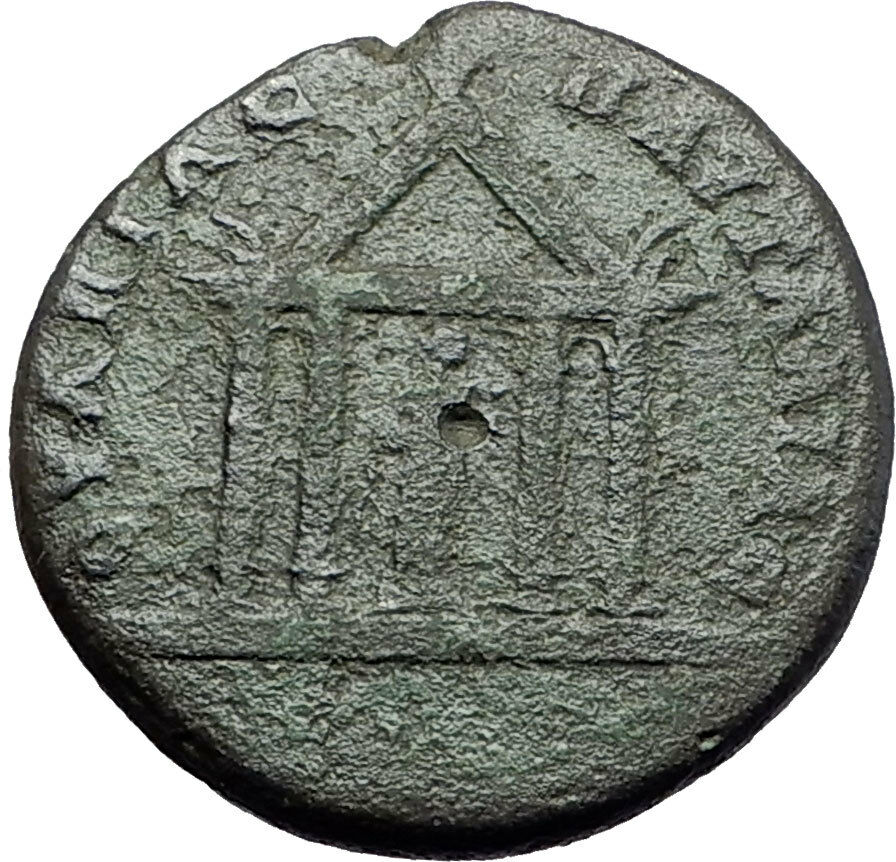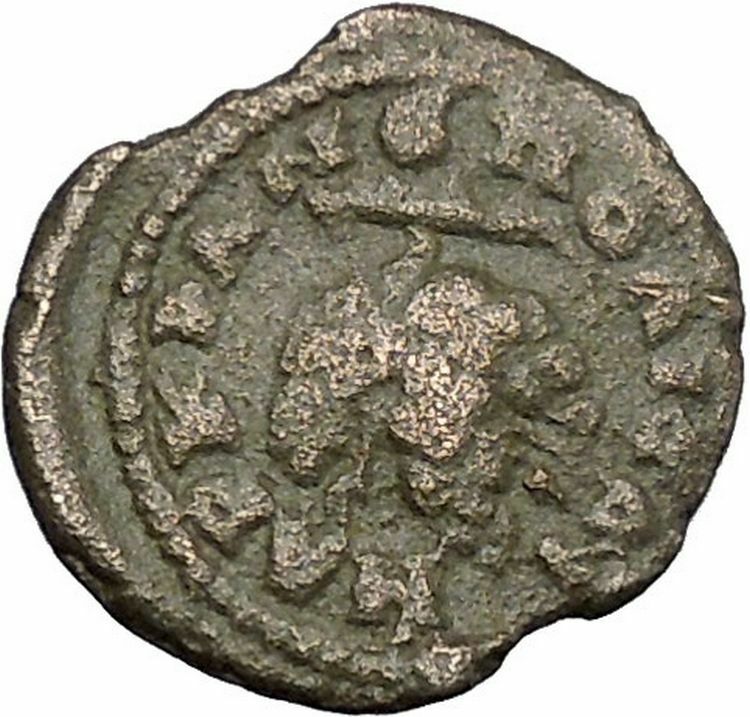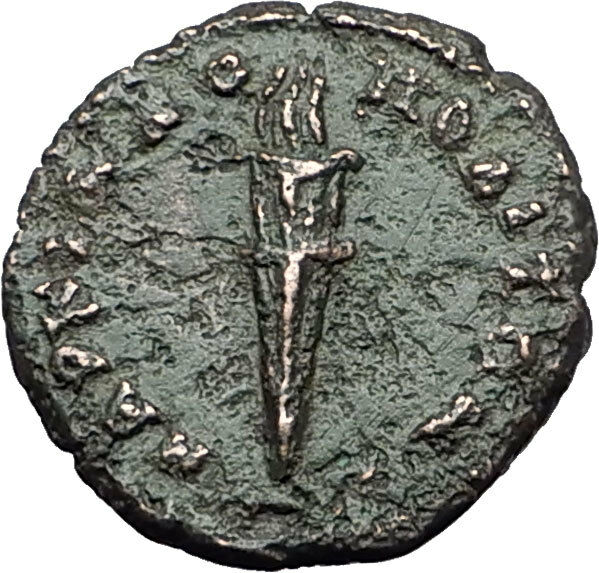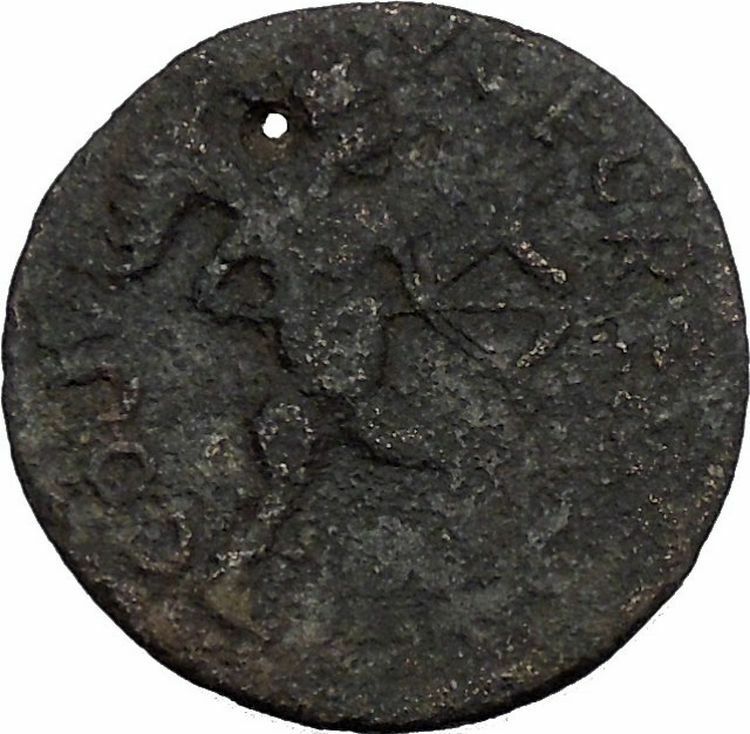|
Julia Mamaea – Roman Empress Wife of Emperor Severus Alexander
222-235 A.D.
Bronze 22mm (5.53 grams) of Bostra in Arabia
Reference: Rosenberger 46; SNG ANS 1231; Kindler 40
IVLIA MAMAEA AVGVSTA, Diademed and draped bust of Mamaea right.
COLONIA BOSTRA, Turreted and draped bust of Tyche left, cornucopia over shoulder.
You are bidding on the exact item pictured,
provided with a Certificate of Authenticity and Lifetime Guarantee of
Authenticity.
Tyche (Greek for luck; the Roman equivalent was
Fortuna
) was the presiding
tutelary deity
that governed the fortune and
prosperity of a city, its destiny. Increasingly during the Hellenistic period,
cities had their own specific iconic version of Tyche, wearing a
mural crown
(a crown like the walls of the
city).

The
Greek historian Polybius
believed that when no cause can be
discovered to events such as floods, droughts, frosts or even in politics, then
the cause of these events may be fairly attributed to Tyche.
Stylianos Spyridakis concisely expressed Tyche’s appeal in a
Hellenistic world of arbitrary violence and unmeaning reverses: “In the
turbulent years of the
Epigoni of Alexander
, an awareness of the
instability of human affairs led people to believe that Tyche, the blind
mistress of Fortune, governed mankind with an inconstancy which explained the
vicissitudes of the time.”
In literature, she might be given various genealogies, as a daughter of
Hermes
and
Aphrodite
, or considered as one of the
Oceanids
, daughters of
Oceanus
and
Tethys
, or of
Zeus. She was connected with
Nemesis
and
Agathos Daimon
(“good spirit”).
She was uniquely venerated at
Itanos
in Crete, as Tyche Protogeneia,
linked with the Athenian
Protogeneia
(“firstborn”), daughter of
Erechtheus
, whose self-sacrifice saved the
city.
She had temples at
Caesarea Maritima
,
Antioch
,
Alexandria
and
Constantinople
. In
Alexandria
the Tychaeon, the temple of
Tyche, was described by
Libanius
as one of the most magnificent of the
entire Hellenistic world.
Tyche appears on many
coins
of the Hellenistic period in the three
centuries before the Christian era, especially from cities in the Aegean.
Unpredictable turns of fortune drive the complicated plotlines of
Hellenistic romances
, such as
Leucippe and Clitophon
or
Daphnis and Chloe
. She experienced a
resurgence in another era of uneasy change, the final days of publicly
sanctioned
Paganism
, between the late-fourth-century
emperors
Julian
and
Theodosius I
who definitively closed the
temples. The effectiveness of her capricious power even achieved respectability
in philosophical circles during that generation, though among poets it was a
commonplace to revile her for a fickle harlot.
In medieval art
, she was depicted as carrying a
cornucopia
, an
emblematic
ship’s rudder, and the
wheel of fortune
, or she may stand on the
wheel, presiding over the entire circle of fate.
The constellation of
Virgo
is sometimes identified as the heavenly
figure of Tyche, as well as other goddesses such as
Demeter
and
Astraea
.
Julia
Avita Mamaea (14 or 29 August after 180–235) was the second daughter of
Julia
Maesa
, a powerful
 Roman woman of Syrian Roman woman of Syrian
Arab
origin and Syrian noble
Julius Avitus
. She was a niece of empress
Julia
Domna
and
emperor
Septimius Severus
and sister of
Julia Soaemias
. She was born and raised in
Emesa
(modern
Homs
, Syria
).
Julia’s first husband was a former consul (whose name is unknown) who died.
Julia married as her second husband Syrian
Promagistrate
Marcus Julius Gessius Marcianus
. Julia bore Marcianus two children, a
daughter called Theoclia (little is known of her) and a son, Marcus Julius
Gessius Bassianus Alexianus, later emperor
Alexander Severus
. Unlike her sister, Julia Mamaea was reported to be a
virtuous woman, never involved in scandals.
As a member of the Imperial Roman family, she watched closely the death of
her cousin Caracalla
and the ascent to power of her nephew
Elagabalus
,
the oldest grandson of Julia Maesa and her choice to the throne. Eventually
Elagabalus and his mother Julia Soaemias proved incompetent rulers and favour
fell on Alexander, Julia’s son. He became emperor in 222, following Elagabalus’
murder by the
Praetorian Guard
. Julia and her mother became regents in the name of
Alexander, then 14 years old. Upon adulthood, Alexander confirmed his esteem for
his mother and named her consors imperii (imperial consort). It was in
this condition that she accompanied her son in his campaigns: a custom started
with Julia Domna
. Thus she travelled to the East, for the campaign against
Parthia
and
to the Germania provinces. Julia Mamaea was with Alexander in Moguntiacum
(modern Mainz
),
capital of
Germania Superior
, when he was assassinated by his troops. She suffered the
same fate.
In the
material culture
of
classical antiquity
, a phiale or
patera (Latin pronunciation: [ˈpatera])
is a shallow ceramic or metal
libation
bowl. It often has a bulbous
indentation (omphalos,
“bellybutton”) in the center underside to facilitate holding it, in which case
it is sometimes called a mesomphalic phiale. It typically has no handles,
and no feet. (A drinking cup with handles is a
kylix
. A circular platter with a pair of
C-handles is not a patera, but a few paterae have a single long straight
handle.) Although the two terms may be used interchangeably, particularly in the
context of
Etruscan culture
, phiale is more common
in reference to Greek forms, and patera in a Roman setting.
-
Silver phiale (620-590 BC, from
Bayindir
village,
Elmali
, present-day Turkey
-
Octopus and dolphin motifs on a ceramic phiale (510–500 BC, from
Eretria
,
Euboea
)
-
Golden phiale (4th–3rd century BC)
-
Silver patera from
Hispania
(Roman
Spain), 2nd–1st century BC)
Use

A youth pours a libation to the deceased within a
naiskos
, a scene that may also
represent
Ganymede
serving
Zeus
( Apulian
red-figure
krater
, 340–320 BC)
Libation was a central and vital aspect of
ancient Greek religion
, and one of the simplest
and most common forms of religious practice. It is one of the basic religious
acts that define piety in ancient Greece, dating back to the
Bronze Age
and even
prehistoric Greece
. Libations were a part of
daily life, and the pious might perform them every day in the morning and
evening, as well as to begin meals. A libation most often consisted of mixed
wine and water, but could also be unmixed wine, honey, oil, water, or milk.
The form of libation called spondē is typically the ritualized pouring
of wine from a jug or bowl held in the hand. The most common ritual was to pour
the liquid from an
oinochoē
(wine jug) into a phiale. Libation
generally accompanied prayer. The Greeks stood when they prayed, either with
their arms uplifted, or in the act of libation with the right arm extended to
hold the phiale. After the wine offering was poured from the phiale, the
remainder of the contents was drunk by the celebrant.
In Roman art
, the libation is shown performed at
an
altar, mensa (sacrificial meal table)
,
or
tripod
. It was the simplest form of sacrifice,
and could be a sufficient offering by itself. The introductory rite
(praefatio) to an animal sacrifice included an incense and wine libation
onto a burning altar. Both
emperors
and divinities are frequently
depicted, especially on coins, pouring libations from a patera. Scenes of
libation and the patera itself commonly signify the quality of
pietas
, religious duty or reverence.
-
Libation at a
symposium
(Attic
red-figure cup, ca. 480 BC)
-
Apollo pouring a libation (Attic
white-ground
kylix
, ca. 460 BC)
-
Etruscan priest with phiale (2nd century BC)
-
Roman priest,
capite velato
(2nd–3rd century
AD)
|






 Roman woman of Syrian
Roman woman of Syrian
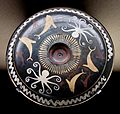

_01.jpg/117px-Pátera_ibera_de_Perotito_(M.A.N._1917-39-1)_01.jpg)





